First off, I apologize for the length of this. But I want you to have all of the relevant information.
A couple months back, I purchased a RAM 98955 kit for a 2011 Mustang V6. The car is being used for endurance racing (Champ Car). Our first event was at Daytona a couple weekends back.

I chose this clutch set because I have the same style in my 1995 Mustang. That car is probably about the same weight, but has a very healthy 427w. It's used for road course and autocross. I shift around 7000 RPM. I have NEVER had a single hiccup. Never a slip, groan, whine, squeal, moan, trill, whir, sizzle, or ANY other noise. It holds the power AND the modulation is great, too. Takes off easy, reasonable weight pedal, etc...it's been just perfect in that car. I wanted ALL of those same qualities in this 2011 Mustang, so I picked the 98955 up. I figured this clutch would live forever behind an engine with 1/2 the power of my 1995's 427, especially just being driven on the track (no hard takeoffs from standstill like the 1995 sees at autocross on grippy concrete).
Since this is a V6 car, it was originally equipped with the dual mass flywheel. We wanted to convert to the more common (and much lighter) Mustang GT setup. So I also purchased the RAM 78513 spacer that installs to the MT82 and moves the throwout bearing 3/4" closer to the flywheel. And a new flywheel listed for a 2011 Mustang GT (an ACT Pro-Lite Xact Billet Steel piece, part number 600430). We used new Ford Performance M-6379-C flywheel bolts and reused the factory throwout bearing (the clutch had worked perfectly fine before, we just wanted light and fresh for this track event).
We installed all of that about 3 weeks ago. We drove the car around town, to the exhaust shop, down the road to get a feel for everything. No issues and everyone praised the clutch at that time.
Then we got to the event. My brother got in the car first and took off. He said everything was perfect, the car was handling great, etc. About 50 minutes into his stint, he says that he thinks the transmission is gone. The car quit pulling, died, and wouldn't fire back up. So he gets towed back into the garages. I am quizzing him all this time...what did it sound like, what did you feel, any shaking or vibrating, etc? He says no strange noises, just came off the front section, braked for the turn, made it around Turn 1, and the car quit pulling and died. Weird. We pull the starter off to see what we can find.
The nose cone has visible wear, almost as if the flywheel had made contact and ground it down. We go ahead and pull the transmission out. We find a mess in the bellhousing. There's a witness mark all the way around the bellhousing from metal spinning inside. The rivets are gone from the Metallic side of the clutch. The Organic side appears to be ok and is still attached to the center hub. It was a chunk of the Metallic side of the clutch that had scored the bellhousing and starter. The "fingers" on the pressure plate are bent on one side. There are no heat marks on the friction surfaces of either the pressure plate or the flywheel. They look brand new (almost as if...they are).
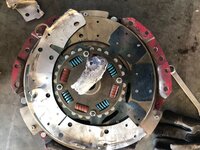
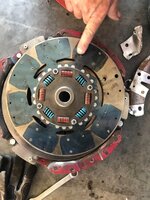
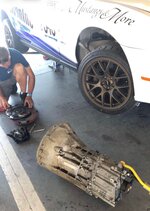
At this point, we just need to get the car running and back on track. So we send my sister and dad to AutoZone to get one of China's Finest Duralast OE Replacement clutch sets. They bring it back, we install the new clutch, new pressure plate, and TOB, reinstall the trans, and get back on track. I was the first driver after the trans went back in. Everything seemed ok unless the RPM's got anywhere over 5500. From there up, I would put the clutch pedal in and make the shift, but the pedal would stay on the floor UNTIL I let the engine RPM come down. Then it would reengage suddenly. If I pulled it up with my foot, the pedal would return, but the clutch disc itself would not ALWAYS entirely reengage until RPMs came down (though sometimes it would).
Anyway, we kept driving. We have laps to put in and we didn't drive 1500 miles one way to let this issue stop us. When I pitted and changed drivers, I explained what was happening to my brother. He said that he had completely forgotten about it up to that point, but that the RAM clutch had done that to him just once, early on, when he had gone higher RPM than planned (our agreed-upon shift point was 6200). He let off and it popped back, but he definitely remembered it hiccupping and not engaging immediately when he let the pedal out. Another two guys drove after me, then my brother again, for a total of about 2 hours. The same behavior from the clutch continued through all of these sessions.
I got back in and drove some more. About 45 minutes in, I was coming out of the bus stop, already in 3rd gear, already with clutch engaged, coasting. I went from part throttle to full throttle getting back on the high banks and the engine seemed to free rev suddenly, up to around 6000 before I was able to react and let off. No smoke that I saw, but definitely the smell of burning clutch. I got down to the flat apron out of traffic. I put it in 2nd, and tried to keep moving, but the engine just rev'd freely in gear. I was able to VERY lightly hold down on the throttle and limp back to the Pits. I checked in with the pit-in station and then tried to take off in 1st gear. At this point, the clutch pedal stayed solidly on the floor. No return action whatsoever. Using the side of my foot, I pulled it off the floor slowly. As I did, the clutch started to engage the flywheel again. I got it back to the garage and we called it a day. When we went to load it up, the clutch wouldn't hold enough to even get it back on the trailer. My brother tried using one foot above and one below the clutch to engage (same way I got it to the garage), but it just started smoking and wouldn't go up the trailer. We pushed it in, packed up, and headed out.
Now we're trying to figure out what may have caused both clutches to fail. We haven't torn the car back down to look at the AutoZone clutch, yet. Just fishing for ideas from you folks that know these cars/transmissions better (I run an old TR3550 with cable clutch in my 95, not exactly apples to apples). Could this be a hydraulic issue? If so, why would the clutch feel perfect in the pits and driving around town? And why would letting the RPMs come down or short shifting make the clutch not do that? Wouldn't that keep the clutch partially engaged and cause some heat marks from it slipping on the pressure plate or flywheel (which we didn't have with the first RAM clutch, but probably do have with the AZ clutch now, at the least because of the trailer loading)? Besides, it isn't as though the clutch material on the metallic side was worn far enough to grind the rivet heads down or anything...there was still plenty of friction material on that mangled portion of the clutch disc (which you can see in the photo above).
Could the throwout bearing be overstroking the fingers on the pressure plate? Could it have simply been a defect in the rivets on the RAM unit? Loose or possibly a rivet head sticking out? That wouldn't explain the loss of the second Duralast clutch, but I suppose that could be chalked up to a cheap clutch being run harder than it was built to run. Still, two clutches in one day would just be REALLY bad luck if they're unrelated. And my cousin is of the strong opinion that the AutoZone clutch should have done fine...that road courses are easy on clutches.
I should mention that it is possible that my brother had a bad downshift that overcame the shear strength of the rivets. BUT all I have is his account of what happened, and he's adamant that he was clutch in WITH brakes as he was slowing down, then blipping the throttle and releasing the clutch just before he started powering out of the corner. Says that he didn't have any occasions where he upshifted or downshifted into the wrong gear or anything like that. I pretty well believe him, as the transmission itself was one of our big worries about the car (the MT82 doesn't exactly have a sterling reputation for it's longevity on track) and we ALL wanted the car to make it.
Anyway, any help you can give would be GREATLY appreciated.
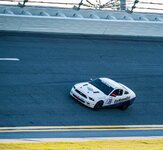
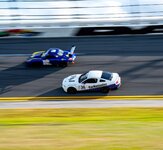

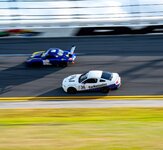
A couple months back, I purchased a RAM 98955 kit for a 2011 Mustang V6. The car is being used for endurance racing (Champ Car). Our first event was at Daytona a couple weekends back.

I chose this clutch set because I have the same style in my 1995 Mustang. That car is probably about the same weight, but has a very healthy 427w. It's used for road course and autocross. I shift around 7000 RPM. I have NEVER had a single hiccup. Never a slip, groan, whine, squeal, moan, trill, whir, sizzle, or ANY other noise. It holds the power AND the modulation is great, too. Takes off easy, reasonable weight pedal, etc...it's been just perfect in that car. I wanted ALL of those same qualities in this 2011 Mustang, so I picked the 98955 up. I figured this clutch would live forever behind an engine with 1/2 the power of my 1995's 427, especially just being driven on the track (no hard takeoffs from standstill like the 1995 sees at autocross on grippy concrete).
Since this is a V6 car, it was originally equipped with the dual mass flywheel. We wanted to convert to the more common (and much lighter) Mustang GT setup. So I also purchased the RAM 78513 spacer that installs to the MT82 and moves the throwout bearing 3/4" closer to the flywheel. And a new flywheel listed for a 2011 Mustang GT (an ACT Pro-Lite Xact Billet Steel piece, part number 600430). We used new Ford Performance M-6379-C flywheel bolts and reused the factory throwout bearing (the clutch had worked perfectly fine before, we just wanted light and fresh for this track event).
We installed all of that about 3 weeks ago. We drove the car around town, to the exhaust shop, down the road to get a feel for everything. No issues and everyone praised the clutch at that time.
Then we got to the event. My brother got in the car first and took off. He said everything was perfect, the car was handling great, etc. About 50 minutes into his stint, he says that he thinks the transmission is gone. The car quit pulling, died, and wouldn't fire back up. So he gets towed back into the garages. I am quizzing him all this time...what did it sound like, what did you feel, any shaking or vibrating, etc? He says no strange noises, just came off the front section, braked for the turn, made it around Turn 1, and the car quit pulling and died. Weird. We pull the starter off to see what we can find.
The nose cone has visible wear, almost as if the flywheel had made contact and ground it down. We go ahead and pull the transmission out. We find a mess in the bellhousing. There's a witness mark all the way around the bellhousing from metal spinning inside. The rivets are gone from the Metallic side of the clutch. The Organic side appears to be ok and is still attached to the center hub. It was a chunk of the Metallic side of the clutch that had scored the bellhousing and starter. The "fingers" on the pressure plate are bent on one side. There are no heat marks on the friction surfaces of either the pressure plate or the flywheel. They look brand new (almost as if...they are).



At this point, we just need to get the car running and back on track. So we send my sister and dad to AutoZone to get one of China's Finest Duralast OE Replacement clutch sets. They bring it back, we install the new clutch, new pressure plate, and TOB, reinstall the trans, and get back on track. I was the first driver after the trans went back in. Everything seemed ok unless the RPM's got anywhere over 5500. From there up, I would put the clutch pedal in and make the shift, but the pedal would stay on the floor UNTIL I let the engine RPM come down. Then it would reengage suddenly. If I pulled it up with my foot, the pedal would return, but the clutch disc itself would not ALWAYS entirely reengage until RPMs came down (though sometimes it would).
Anyway, we kept driving. We have laps to put in and we didn't drive 1500 miles one way to let this issue stop us. When I pitted and changed drivers, I explained what was happening to my brother. He said that he had completely forgotten about it up to that point, but that the RAM clutch had done that to him just once, early on, when he had gone higher RPM than planned (our agreed-upon shift point was 6200). He let off and it popped back, but he definitely remembered it hiccupping and not engaging immediately when he let the pedal out. Another two guys drove after me, then my brother again, for a total of about 2 hours. The same behavior from the clutch continued through all of these sessions.
I got back in and drove some more. About 45 minutes in, I was coming out of the bus stop, already in 3rd gear, already with clutch engaged, coasting. I went from part throttle to full throttle getting back on the high banks and the engine seemed to free rev suddenly, up to around 6000 before I was able to react and let off. No smoke that I saw, but definitely the smell of burning clutch. I got down to the flat apron out of traffic. I put it in 2nd, and tried to keep moving, but the engine just rev'd freely in gear. I was able to VERY lightly hold down on the throttle and limp back to the Pits. I checked in with the pit-in station and then tried to take off in 1st gear. At this point, the clutch pedal stayed solidly on the floor. No return action whatsoever. Using the side of my foot, I pulled it off the floor slowly. As I did, the clutch started to engage the flywheel again. I got it back to the garage and we called it a day. When we went to load it up, the clutch wouldn't hold enough to even get it back on the trailer. My brother tried using one foot above and one below the clutch to engage (same way I got it to the garage), but it just started smoking and wouldn't go up the trailer. We pushed it in, packed up, and headed out.
Now we're trying to figure out what may have caused both clutches to fail. We haven't torn the car back down to look at the AutoZone clutch, yet. Just fishing for ideas from you folks that know these cars/transmissions better (I run an old TR3550 with cable clutch in my 95, not exactly apples to apples). Could this be a hydraulic issue? If so, why would the clutch feel perfect in the pits and driving around town? And why would letting the RPMs come down or short shifting make the clutch not do that? Wouldn't that keep the clutch partially engaged and cause some heat marks from it slipping on the pressure plate or flywheel (which we didn't have with the first RAM clutch, but probably do have with the AZ clutch now, at the least because of the trailer loading)? Besides, it isn't as though the clutch material on the metallic side was worn far enough to grind the rivet heads down or anything...there was still plenty of friction material on that mangled portion of the clutch disc (which you can see in the photo above).
Could the throwout bearing be overstroking the fingers on the pressure plate? Could it have simply been a defect in the rivets on the RAM unit? Loose or possibly a rivet head sticking out? That wouldn't explain the loss of the second Duralast clutch, but I suppose that could be chalked up to a cheap clutch being run harder than it was built to run. Still, two clutches in one day would just be REALLY bad luck if they're unrelated. And my cousin is of the strong opinion that the AutoZone clutch should have done fine...that road courses are easy on clutches.
I should mention that it is possible that my brother had a bad downshift that overcame the shear strength of the rivets. BUT all I have is his account of what happened, and he's adamant that he was clutch in WITH brakes as he was slowing down, then blipping the throttle and releasing the clutch just before he started powering out of the corner. Says that he didn't have any occasions where he upshifted or downshifted into the wrong gear or anything like that. I pretty well believe him, as the transmission itself was one of our big worries about the car (the MT82 doesn't exactly have a sterling reputation for it's longevity on track) and we ALL wanted the car to make it.
Anyway, any help you can give would be GREATLY appreciated.

















